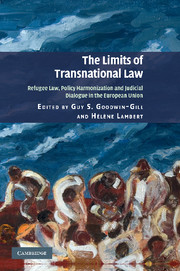 The Limits of Transnational Law
The Limits of Transnational Law Book contents
- Frontmatter
- Contents
- Notes on contributors and editors
- Acknowledgements
- Abbreviations
- 1 Transnational law, judges and refugees in the European Union
- 2 Where is the reference? On the limited role of transnational dialogue in Belgian refugee law
- 3 Transnational refugee law in the French courts: deliberate or compelled change in judicial attitudes?
- 4 The use of foreign asylum jurisprudence in the German administrative courts
- 5 The solipsistic legal monologue of Italian authorities
- 6 ‘Thou shalt not judge’ … Spanish judicial decision-making in asylum and the role of judges in interpreting the law
- 7 The British judiciary and the search for reciprocal relations with its continental partners
- 8 Speaking across borders: the limits and potential transnational dialogue on refugee law in Ireland
- 9 The absence of foreign law in Danish asylum decisions – quasi-judicial monologue with domestic policy focus?
- 10 Foreign law in Swedish judicial decision-making: playing a limited role in refugee law cases
- 11 The search for the one, true meaning …
- Bibliography
- Index
6 - ‘Thou shalt not judge’ … Spanish judicial decision-making in asylum and the role of judges in interpreting the law
Published online by Cambridge University Press: 06 July 2010
- Frontmatter
- Contents
- Notes on contributors and editors
- Acknowledgements
- Abbreviations
- 1 Transnational law, judges and refugees in the European Union
- 2 Where is the reference? On the limited role of transnational dialogue in Belgian refugee law
- 3 Transnational refugee law in the French courts: deliberate or compelled change in judicial attitudes?
- 4 The use of foreign asylum jurisprudence in the German administrative courts
- 5 The solipsistic legal monologue of Italian authorities
- 6 ‘Thou shalt not judge’ … Spanish judicial decision-making in asylum and the role of judges in interpreting the law
- 7 The British judiciary and the search for reciprocal relations with its continental partners
- 8 Speaking across borders: the limits and potential transnational dialogue on refugee law in Ireland
- 9 The absence of foreign law in Danish asylum decisions – quasi-judicial monologue with domestic policy focus?
- 10 Foreign law in Swedish judicial decision-making: playing a limited role in refugee law cases
- 11 The search for the one, true meaning …
- Bibliography
- Index
Summary
Introduction
Spain has traditionally been a country of emigration. However, during the mid 1980s, a regular trend of increasing immigration emerged that over time has modified the demographic composition of the country. The number of non-nationals living in Spain has been rising quickly and at 1 January 2009 more than five and a half million foreigners (5,598,691 people) were registered as living in Spain. Of them, 40.18 per cent had received a residence card under European Community (EC) law and 39.73 per cent under the general immigration regime. Accordingly, 20.09 per cent of the foreigners registered in the country at that time were not lawfully resident (although this figure includes lawfully present individuals whose claims were still pending). Given that the Spanish census at 1 January 2009 recorded a population of more than forty-six and a half million people, about 12 per cent of the Spanish population at that time were non-nationals. Since then the figure has continued to rise and the number of non-nationals lawfully resident in the country increased to 4,495,349 foreigners lawfully resident at 31 December 2009.
These figures are relevant, not only as they reveal a clear immigration trend, but also in so far as they include individuals whose grounds for residence arise from a protection claim other than refugee status under the 1951 Convention Relating to the Status of Refugees (Refugee Convention). Therefore, individuals granted subsidiary protection or other protection-related statuses are included in these statistics.
- Type
- Chapter
- Information
- The Limits of Transnational LawRefugee Law, Policy Harmonization and Judicial Dialogue in the European Union, pp. 107 - 124Publisher: Cambridge University PressPrint publication year: 2010
